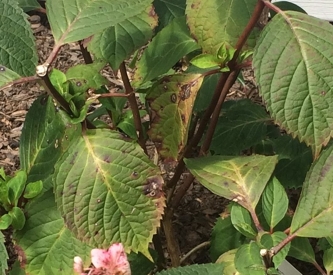Examine This Report about Hydrangea Leaves Turning Yellow
Wiki Article
The Greatest Guide To Hydrangea Leaves Turning Yellow
Table of ContentsThe Only Guide to Hydrangea Leaves Turning YellowWhat Does Hydrangea Leaves Turning Yellow Do?8 Easy Facts About Hydrangea Leaves Turning Yellow DescribedSome Known Details About Hydrangea Leaves Turning Yellow
One possibility is that the plant is not getting enough sunlight. During the cold weather, the days are much shorter, and the sun is not as intense, so ensure to position your Hydrangea in a place where it will certainly obtain at least six hours of sunlight daily. Another factor for Hydrangea yellow leaves in wintertime can be way too much water.The fallen leaves may be turning yellow due to temperature level tension. Hydrangeas like cooler temperature levels, so if the plant is in an area that gets as well warm or too cold, the fallen leaves will turn yellow. If you think temperature stress may be the problem, try relocating your Hydrangea to a various area or shielding it from the elements with a cloth cover.
New development will be observed in early springtime, when you'll notice environment-friendly foliage growing from stems that may have appeared dead. Nonetheless, if your leaves are turning brown in springtime or summer season, there are most likely various other aspects at play. The precise factors depend upon the selection and their expanding problems, but as a whole, brownish hydrangea fallen leaves signify dehydration and wilting in the warm
In the spring when the mercury remains reasonably reduced, they'll do great. When points warm up over the summer nevertheless, time spent in the early mid-day rays can cause unimaginable damage.: Expand your hydrangeas in a place where they'll obtain sunlight in the mornings or evenings, but not throughout the peak hours.
The Of Hydrangea Leaves Turning Yellow
Wilting is caused by absence of moisture, meaning there are a couple of good techniques to make use of to prevent this from occurring. Provide your hydrangeas a healthy and balanced glug of water every couple of days when the temperature levels are climbing up high, and deal with the soil to much better preserve moisture. After watering, a bit of mulch around the base of each plant need to help with this by maintaining wetness in the soil.This interrupts fungi spores from clearing up. "The Botrytis fungi grows in amazing and wet conditions, so avoid showering the entire plant when sprinkling and simply water at the roots," shares Roy Nicol, a Master Horticulturist - Hydrangea Leaves Turning Yellow. If you've missed the chance for prevention and are taking care of an infection you ought to get rid of all dead or badly contaminated fallen leaves from the plant and ruin them to prevent further spread
As a basic regulation of thumb, we advise getting rid of fallen leaves when they are 50% brownish or greater. While browning created by any kind of factor can not be turned around, taking the rehabilitative activity defined above will certainly encourage the plant to grow brand-new leaves so the damaged fallen leaves either fall off naturally or can be removed by the garden enthusiast.
Hydrangeas should be this sprinkled only when the top couple of inches of soil are dry, and must be provided a thorough saturating each time. Underwatered hydrangeas are likely to have yellow, wilting, and sagging leaves.
The 9-Second Trick For Hydrangea Leaves Turning Yellow
The method you repair hydrangea leaves turning yellow depends on the key problem creating the yellow leaves. This can be hard to identify, once you do you will be able to change your plant treatment accordingly to take treatment of the problem. As discussed previously, a common issue with hydrangeas is vitamins and mineral deficiencies.Throughout the peak growing period, you must water at a price of about 1 inch weekly. If you are fretted about not effectively watering your hydrangeas, there are a number of points you can do. Including mulch go to this website to the base of the plants over the root area aid to regulate the temperature around the shrub and keep water in the dirt.

If it is too severe, some plants will certainly never recover from transplant shock and will certainly remain to decline up until they pass away. Minimize transplant shock by including as lots of roots as feasible when excavating up your plant to relocate. Make certain to give even more water than typical in the weeks adhering to planting to aid your plant recover and grow new origins.
The Best Guide To Hydrangea Leaves Turning Yellow
To avoid spreading out fungal conditions, make sure to thouroughly clean and decontaminate any kind of trimming tools prior to and after use. Finally, you can attempt to flush the roots with water to get rid of excess fertlizer.:max_bytes(150000):strip_icc()/GettyImages-13748759001-8a80ca41bf6b46ffa27f748339a58287.jpg)
If you don't sprinkle your hydrangea plant for more than a week, the leaves will certainly begin transforming yellow. Fungal illness that strike the plants tend to reveal indicators on the origins and the leaves of the plant.
Fallen leave place is an additional fungal disease that can target hydrangea. It results in the fallen leaves turning yellow and the appearance of brownish and purple spots on the leaves.
Report this wiki page